Fujifilm Finepix REAL 3D W3 Review
Fujifilm Finepix REAL 3D W3 Performance - How well does it take pictures?
The Fuji Finepix REAL 3D W3 has the unique position of being the only 3D camera reviewed here. Since the only other 3D digital camera is its predecessor, the W1, there is a good chance the W3 is the best 3D camera anywhere. There are really two options for those looking for a 3D digital camera, buy the REAL 3D W3 or wait for something new. Nothing has been announced yet, although you can get a Micro Four-Thirds camera with a 3D fixed-focal fixed-aperture lens instead. See the yellow box on this review page for a comparison between these two options.
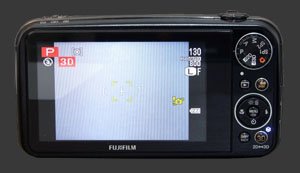 With all digital cameras, apparent image quality is relative to the viewing medium. A photo which may look soft on a 24x16" print may look perfect on a 4x6". That is why we normally note the maximum print size at different ISO sensitivities. Unfortunately, we were not able to print any 3D images. The technology exists but it is only currently done in Japan and the processing delay is quoted as 20 days. It is also quite pricey. Another viewing option is a 3D HDTV which we have no access to as well. The only remaining 3D viewing option is the nice 1.15 megapixels 3.5" LCD on the camera itself.
With all digital cameras, apparent image quality is relative to the viewing medium. A photo which may look soft on a 24x16" print may look perfect on a 4x6". That is why we normally note the maximum print size at different ISO sensitivities. Unfortunately, we were not able to print any 3D images. The technology exists but it is only currently done in Japan and the processing delay is quoted as 20 days. It is also quite pricey. Another viewing option is a 3D HDTV which we have no access to as well. The only remaining 3D viewing option is the nice 1.15 megapixels 3.5" LCD on the camera itself.
While we can say that images look good on the camera's lenticular LCD with a perceptible 3D effect, quality is not measurable there. Case in point, shooting across the entire ISO range shows nearly no difference on the 3.5" LCD. This corresponds to a rather small 3x2" print. So, if that is the viewing medium, then ISO is of no real importance and even the top setting of 1600 delivers usable results. This is unfortunately not informative and for the remainder of this review section will focus on the 2D image quality instead with the understanding that there is certainly some correlation between this camera's 2D and 3D performance.
Colors from the W3 are fairly accurate in the Standard color mode. There is also a Chrome mode which dramatically increases color-saturation and a B&W mode for black-and-white photography. The 3D effect seems unaffected by the choice of color modes. Color accuracy is obviously affected by white-balance and the W3 shows truly excellent WB accuracy in Auto mode. There are also 7 preset options in case the AWB does not produce desirable results. No custom white-balance option is available, so tricky situations are going to be a real pain for 3D images. Fuji software can be used to split 3D images into pairs of 2D JPEG images, which a can be corrected in any image editing application. The manipulated images can be assembled back into a 3D file. The trick is to apply the same pixel-level processing to both images and not move or crop any pixels. That can be done in Adobe's Lighroom using the Synchronize feature. As MPO files become more popular, software are expected to eventually pick up capabilities to deal with them.
The short ISO range of the W3 is easily explained by closely looking at its images. The base ISO 100 produces very usable results with a slight amount of visible noise already. Most fine details are preserved there and at ISO 200 as well. ISO 400 gets a bit more noisy and eats way a slight amount of details, yet remains sufficiently clear for a nice medium-sized print, like a 12x8". Fine details get further destroyed at ISO 800 and print sizes are now more limited. The top ISO sensitivity of 1600 is usable for small 4x6" prints but anything larger will show that noise-levels are quite high. This is on par with the average modern compact camera. Considering price though, several similarly priced 2D-only cameras show superior image quality.
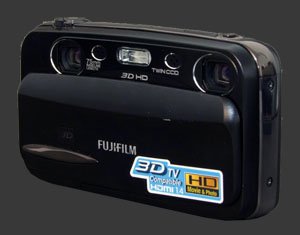
The dual folded-optics lenses on the W3 deliver a good amount of details in the central part of images but suffer from severe softness along the side edges when shooting in landscape orientation. This problem was more pronounced on the left than on the right with our review unit. Vignetting is also a problem with a stronger impact at wide-angle. Also, be careful not to add your own corner shading by placing your fingers too close to the lens. Some barrel distortion is clearly visible at wide-angle but goes away when zoomed-in. The lens' performance seems to suggest that Fuji had to keep costs down in order to afford two lenses in one camera, something which is perfectly understandable given that lenses are one of the most expensive parts of any camera.
Multi-Segment metering accuracy is reasonable on this digital camera. It exposes images on the bright side which is preferable for direct use but can easily blow-out highlights in scenes with a wide dynamic-range. For typical cases, EC not often required though. Spot and Average metering modes are also available and they perform as expected. The dynamic range of the W3 is fair for a compact camera as well.
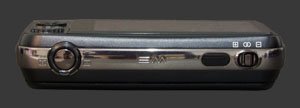 The Fuji W3 starts up in about 4 seconds which certainly on the slow side. Shutting down is quick though. Focusing takes around 1 second depending on light levels. This is on the slow side of average. Many small cameras take longer to focus, but there are several faster ones from Fuji. Focusing is done with one of nine large areas or with the central point, which is the only one used in 3D mode. Focus is accurate and rarely misses except in very low-light. By default in 3D mode, the camera automatically sets the parallax after focus. This means that until the camera is approximately focused at the right distance, it may be difficult to focus your eyes on the rear LCD as it does not show a properly aligned 3D image. Changing parallax with the rocker shows a short lag. Letting go of the parallax controller, it takes about ½s for the 3D image to form again.
The Fuji W3 starts up in about 4 seconds which certainly on the slow side. Shutting down is quick though. Focusing takes around 1 second depending on light levels. This is on the slow side of average. Many small cameras take longer to focus, but there are several faster ones from Fuji. Focusing is done with one of nine large areas or with the central point, which is the only one used in 3D mode. Focus is accurate and rarely misses except in very low-light. By default in 3D mode, the camera automatically sets the parallax after focus. This means that until the camera is approximately focused at the right distance, it may be difficult to focus your eyes on the rear LCD as it does not show a properly aligned 3D image. Changing parallax with the rocker shows a short lag. Letting go of the parallax controller, it takes about ½s for the 3D image to form again.
The shutter-lag itself is short. Shot-to-shot speeds are a bit below average in 2D mode, taking about 2½ seconds between shots. In 3D mode though, shot to shot speed is a glacial 4½ seconds. The remainder of operations are quick. The W3 responds to most button-presses instantly, enters playback mode in less than 1s and goes back to shooting mode instantly. Playback mode itself is fast too, even panning and zooming around 3D images is not a problem. Depending on the parallax, zooming into some images looks strange and causes the visible aspect ratio to change in order to maintain the correct 3D perspective.
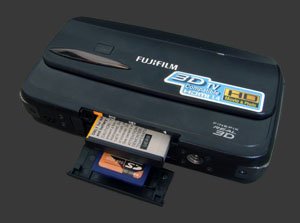 The two things that get used up fast with the Fuji Finepix REAL 3D W3 are the battery and memory. Battery-life is quoted at 150 shots per charge, which is quite low but not surprising considering that the W3 has to power 2 CCDs, 2 lenses and one 3.5" LCD. JPEG images can exceed 5 MB and MPO files can exceed 10 MB each. In JPEG+MPO mode, this means that 15 is being consumed with each press of the shutter. Given the lack of support for MPO files by most imaging software, the 15 MB/shot case is most likely to be quite common for a while.
The two things that get used up fast with the Fuji Finepix REAL 3D W3 are the battery and memory. Battery-life is quoted at 150 shots per charge, which is quite low but not surprising considering that the W3 has to power 2 CCDs, 2 lenses and one 3.5" LCD. JPEG images can exceed 5 MB and MPO files can exceed 10 MB each. In JPEG+MPO mode, this means that 15 is being consumed with each press of the shutter. Given the lack of support for MPO files by most imaging software, the 15 MB/shot case is most likely to be quite common for a while.
Entering and exiting video mode is quick enough. Once there, pressing the shutter instantly starts and stops recording. Focus, parallax and zoom can be set before recording starts but not changed during. The display is accurate and keeps up very well. The W3 can record video until the memory card fills up. Since the file system used on memory cards cannot support files larger than 4 GB, this digital camera starts a new file each time the 4 GB boundary is reached. A small delay is noticeable between clips. Overall, aside from the lenses remaining fixed during recording, the video mode of the W3 is excellent.
The LCD on the W3 is quite an achievement. The viewing angle is wide with the expected catch that 3D images viewed at an angle lose their 3D effect. It is worth noting that photos in portrait orientation cannot give a sense of depth since the two lenses become vertically aligned. While rotating the display, there is a noticeable flicker caused by the lenticular array. Brightness is excellent in normal conditions and can be boosted temporarily to view things in bright light. The image remains rather clear in low-light as well. Motion on the LCD is fluid regardless of the mode used. The lenticular array shows a believable effect of depth when looked straight on. Depending on the subject and parallax, the image can look like it is popping out or receding into the display. The LCD shows an accurate preview of exposure as long as it is viewed straight on and that the camera is in an automatic mode. In Manual mode, the camera shows something which is not exposure-accurate but is bright enough to frame properly under typical conditions.
Fujifilm Finepix REAL 3D W3 Conclusion
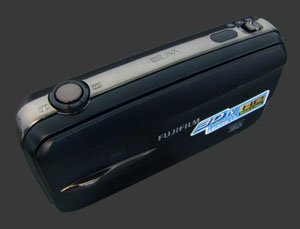 The audacious design Fuji produced to create its first 3D digital cameras is embodied in the W3. Two optical path, two sensors and some powerful processing come together to form what is an undeniably capable 3D product. The amazing 3.5" lenticular display lets photographers compose and review images in 3D without the need for additional devices. While it brings a certain simplicity to capturing 3D images and videos, the REAL 3D W3 introduces the concept of parallax which challenges several fundamentals of photography. As such, jumping into the W3 is more for the technologically savvy than the novice.
The audacious design Fuji produced to create its first 3D digital cameras is embodied in the W3. Two optical path, two sensors and some powerful processing come together to form what is an undeniably capable 3D product. The amazing 3.5" lenticular display lets photographers compose and review images in 3D without the need for additional devices. While it brings a certain simplicity to capturing 3D images and videos, the REAL 3D W3 introduces the concept of parallax which challenges several fundamentals of photography. As such, jumping into the W3 is more for the technologically savvy than the novice.
As a 3D camera, there is no comparison with the W3, literally. It captures image and videos with a good sense of depth. Color, white-balance and exposure all contribute positively to this camera's output quality. As for the output, it is still very expensive to share 3D media due to the high cost of lenticular printing and 3D televisions. Those are bound to come down in price but until then, most people will not be able to see what this camera is capable of. As a 2D camera, the average ISO performance, low optical quality and generally slow operation of the REAL 3D W3 cannot commend such a high price. In other words, this is a 3D camera with a price-tag matching its exclusive status, not its photographic quality.
The bottom line is that the W3 can be seen as a uniquely impressive 3D product or an average camera with a hefty price tag. Which way you go depends on how much fun you can get out of producing images and videos that very few people can. For certain subjects, the addition of 3D perspective really transforms the image into something much more impressive. Many poorly taken 2D images fail because they lack that sense of depth. With the W3, it is the camera that hands down its own sense of depth.
 |
Please Support Neocamera
All information on Neocamera is provided free of charge yet running this website is a huge endeavor. Purchases made via affiliate links found throughout the site help keep it running and up-to-date. There is no additional cost to you, so please consider buying via these links to our affilates:
If you found any information on this site valuable and did not purchase via our affiliate links, please considering donating via PayPal:
Any amount will be greatly appreaciated. Thank you for your support!
Fujifilm REAL 3D W3 Highlights
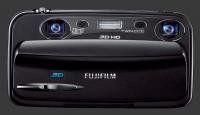
Sensor-Size: 6 x 5mm

Actual size when viewed at 100 DPI
| 10 Megapixels 3D Fixed Lens | ISO 100-1600 |
| 3X Optical Zoom | Shutter 1/1500-3s |
| 1 FPS Drive, 40 Images | Full manual controls |
| 1280x720 @ 24 FPS Video Recording | Spot-Metering |
| 3.5" LCD 1.2 Megapixels | Lithium-Ion Battery |
| Secure Digital High Capacity, Internal Memory |
3D Camera VS 3D Lens
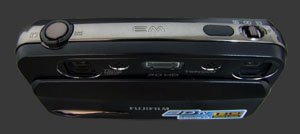
There are a number of ways to produce stereoscopic images. The Fuji Finepix REAL 3D W3 captures two images in a single press of the shutter which are then combined into a 3D image. The same stereoscopic 3D effect can be obtained using:
- Two tripod-mounted cameras remotely fired at the same time. This is the traditional approach. Needless to say it is expensive, heavy and cumbersome.
- One camera with a 3D lens. This very recent approach uses a special lens produces two distorted images onto one sensor.
The 3D lens approach requires an ILC camera with Live-View which reads the distorted image and unscrambles it into a single viewable image for composing and reviewing. Any mirrorless camera system could do this but presently only Micro Four-Thirds cameras have such a lens. None of these cameras have a lenticular screen, so obviously the display remains 2D for both composing and reviewing. Image quality of Micro Four-Thirds cameras is much closer to that of DSLRs than that of fixed-lens ones. This is necessarily the key advantage of the 3D lens approach.
Conversely, the 3D camera approach has a number of advantages. Total cost and size are the obvious two. In terms of 3D perspective, the use of two lenses set 75mm apart should create a much more natural sense of depth than a 3D lens. While an ILC obviously wins in terms of absolute flexibility, the REAL 3D W3 is much more flexible in terms of 3D capabilities:
- It can zoom, allowing for more creative framing.
- The parallax is adjustable to control the rendition of depth.
- Custom parallax is doable in Individual Shutter mode.
- It lets 4x more light in thanks to its wider aperture.
Updates
2024.04.03

Fujifilm X-T5 Review
Newest Fujifilm flagship boasting a 40 MP APS-C sensor, 5-axis IBIS with 7-stop efficiency, 15 FPS continuous drive, 6.2K Video capture, dual control-dials and dual SDXC UHS-II slots in a sturdy weatherproof and freezeproof body.
2023.11.20

Best Digital Cameras of 2023
Find out which are the Best Digital Cameras of 2023. All the new Mirrorless Digital Cameras from entry-level to high-end professional.
2023.07.10

Fujifilm X-H2 Review
40 Megapixels APS-C Hybrid Mirrorless Digital Camera with 7-stop IBIS. Fastest shutter ever and 8K video capture. Large builtin EVF with 0.8X magnification and 5.8 MP, plus an Eye-Start Sensor. Packed with features and large number of controls in a weatherproof and freezeproof body.
2023.05.07

Sony FE 20-70mm F/4G Review
Review of the unique Sony FE 20-70mm F/4G lens. The optical zoom of this lens spans ultra-wide-angle and medium focal-length coverage, making it one of the most versatile Full-Frame lenses on the market.
2023.01.15

Huion Inspiroy Dial 2 Review
Review of the Huion Inspiroy Dial 2 tablet, a medium sized drawing surface with dual dials and customizable buttons. Connects via USB-C or Bluetooth 5.0 with Windows, Linux and Android support.
2022.12.08

How to Pack for a Photo Trip
Find out how to pack for a travel photography trip, carry your gear safely while meeting airline regulations.
2022.11.13

Best Digital Cameras of 2022
The best digital cameras of 2022. A short list of the most outstanding models in their respective categories. Choose one for yourself or as a gift.
2022.09.21

Pentax DA* 60-250mm F/4 SDM Review
Review of the Pentax DA* 60-250mm F/4 SDM, the constant-aperture telephoto zoom with the highest zoom-ratio on the market.
2022.09.20

Pentax DA* 50-135mm F/2.8 SDM Review
Review of the Pentax DA* 50-135mm F/2.8 SDM, the lightest professional telephoto zoom native to the K-mount.
2022.09.10

Pentax DA* 11-18mm F/2.8 DC AW Review
Review of the Pentax DA* 11-18mm F/2.8 DC AW, the widest professional ultra-wide zoom native to the K-mount.
2021.11.24

50 Gifts Under $50 For Photographers in 2021
50 Gifts photographers will love. All for under $50 USD. 2021 Edition.
2021.11.17

Best Digital Cameras for 2021
Neocamera shows which are the very best Digital Cameras for 2021 in every category: Mirrorless, DSLR, Premium Compact, Ultra-Zoom and Rugged.











